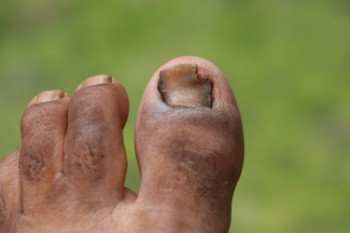Connect With Us
Blog
Items filtered by date: August 2025
Recognizing Toenail Fungus and Its Look-Alikes

Toenail fungus is a common condition that can cause thickened, discolored, or brittle nails. However, not all changes in toenail appearance are due to fungus. Injuries to the nail bed can cause similar discoloration, as can psoriasis, eczema, or certain skin conditions that affect the nails. Repeated pressure from wearing tight shoes may lead to thickening and changes in shape. Some medications or systemic illnesses, such as thyroid disease, can also alter nail color or texture. Because these conditions can look alike, it is important not to self-diagnose or rely on over-the-counter treatments without confirmation. A podiatrist can examine the nail, possibly perform lab testing, and determine the true cause. Accurate diagnosis ensures that the right treatment is used, whether it is antifungal therapy or another form of care. If you notice nail changes, it is suggested that you see a podiatrist for a diagnosis and appropriate treatment.
If left untreated, toenail fungus may spread to other toenails, skin, or even fingernails. If you suspect you have toenail fungus it is important to seek treatment right away. For more information about treatment, contact Lawrence Fallat, DPM of Michigan. Our doctor can provide the care you need to keep you pain-free and on your feet.
Symptoms
- Warped or oddly shaped nails
- Yellowish nails
- Loose/separated nail
- Buildup of bits and pieces of nail fragments under the nail
- Brittle, broken, thickened nail
Treatment
If self-care strategies and over-the-counter medications does not help your fungus, your podiatrist may give you a prescription drug instead. Even if you find relief from your toenail fungus symptoms, you may experience a repeat infection in the future.
Prevention
In order to prevent getting toenail fungus in the future, you should always make sure to wash your feet with soap and water. After washing, it is important to dry your feet thoroughly especially in between the toes. When trimming your toenails, be sure to trim straight across instead of in a rounded shape. It is crucial not to cover up discolored nails with nail polish because that will prevent your nail from being able to “breathe”.
In some cases, surgical procedure may be needed to remove the toenail fungus. Consult with your podiatrist about the best treatment options for your case of toenail fungus.
If you have any questions please contact our offices located in Canton and Taylor, MI . We offer the newest diagnostic and treatment technologies for all your foot and ankle needs.
Ankle Awareness and Its Role in Balance and Sports Performance

The ability to sense joint position, known as proprioception, is essential for stability and movement control. In the ankle, this sense plays a critical role in maintaining balance, especially during quick changes in direction or uneven surfaces common in sports. When ankle proprioception is sharp, athletes can adjust their movements efficiently, reducing the likelihood of missteps or falls. However, injuries like sprains can impair this system, making future injuries more likely. Rehabilitation that includes balance training and targeted exercises helps restore ankle awareness and strengthen neuromuscular coordination. Improved proprioception not only aids recovery but also enhances overall athletic performance by supporting quicker reactions and more confident movements. If you are recovering from an ankle injury or notice ongoing instability, it is suggested you speak with a podiatrist.
Ankle pain can have many different causes and the pain may potentially be serious. If you have ankle pain, consult with Lawrence Fallat, DPM from Michigan. Our doctor will assess your condition and provide you with quality foot and ankle treatment.
Ankle pain is any condition that causes pain in the ankle. Due to the fact that the ankle consists of tendons, muscles, bones, and ligaments, ankle pain can come from a number of different conditions.
Causes
The most common causes of ankle pain include:
- Types of arthritis (rheumatoid, osteoarthritis, and gout)
- Ankle sprains
- Broken ankles
- Achilles tendinitis
- Achilles tendon rupture
- Stress fractures
- Tarsal tunnel syndrome
- Plantar fasciitis
Symptoms
Symptoms of ankle injury vary based upon the condition. Pain may include general pain and discomfort, swelling, aching, redness, bruising, burning or stabbing sensations, and/or loss of sensation.
Diagnosis
Due to the wide variety of potential causes of ankle pain, podiatrists will utilize a number of different methods to properly diagnose ankle pain. This can include asking for personal and family medical histories and of any recent injuries. Further diagnosis may include sensation tests, a physical examination, and potentially x-rays or other imaging tests.
Treatment
Just as the range of causes varies widely, so do treatments. Some more common treatments are rest, ice packs, keeping pressure off the foot, orthotics and braces, medication for inflammation and pain, and surgery.
If you have any questions please feel free to contact our offices located in Canton and Taylor, MI . We offer the newest diagnostic tools and technology to treat your foot and ankle needs.
Tarsal Tunnel Syndrome and Its Impact on Foot Health

Tarsal tunnel syndrome is a condition where the posterior tibial nerve becomes compressed as it passes through the tarsal tunnel along the inner ankle. This can cause pain, tingling, numbness, or burning sensations in the foot and ankle. Common causes include flat feet, swelling, injuries, or conditions that place pressure on the nerve. Symptoms often worsen with prolonged walking or standing and risk factors include obesity, diabetes, and repetitive strain on the foot. A podiatrist can diagnose tarsal tunnel syndrome, provide imaging or nerve testing, and recommend treatments such as orthotics or minimally invasive procedures. If you have pain on the inside of your ankle, it is suggested that you consult a podiatrist who can accurately diagnose and treat the problem.
Tarsal tunnel syndrome can be very uncomfortable to live with. If you are experiencing tarsal tunnel syndrome, contact Lawrence Fallat, DPM of Michigan. Our doctor can provide the care you need to keep you pain-free and on your feet.
Tarsal Tunnel Syndrome
Tarsal tunnel syndrome, which can also be called tibial nerve dysfunction, is an uncommon condition of misfiring peripheral nerves in the foot. The tibial nerve is the peripheral nerve in the leg responsible for sensation and movement of the foot and calf muscles. In tarsal tunnel syndrome, the tibial nerve is damaged, causing problems with movement and feeling in the foot of the affected leg.
Common Cause of Tarsal Tunnel Syndrome
- Involves pressure or an injury, direct pressure on the tibial nerve for an extended period of time, sometimes caused by other body structures close by or near the knee.
- Diseases that damage nerves, including diabetes, may cause tarsal tunnel syndrome.
- At times, tarsal tunnel syndrome can appear without an obvious cause in some cases.
The Effects of Tarsal Tunnel Syndrome
- Different sensations, an afflicted person may experience pain, tingling, burning or other unusual sensations in the foot of the affected leg.
- The foot muscles, toes and ankle become weaker, and curling your toes or flexing your foot can become difficult.
- If condition worsens, infections and ulcers may develop on the foot that is experiencing the syndrome.
A physical exam of the leg can help identify the presence of tarsal tunnel syndrome. Medical tests, such as a nerve biopsy, are also used to diagnose the condition. Patients may receive physical therapy and prescriptive medication. In extreme cases, some may require surgery.
If you have any questions please contact our offices located in Canton and Taylor, MI . We offer the newest diagnostic and treatment technologies for all your foot and ankle needs.
Inspect Your Feet Regularly for Abnormalities if You're Diabetic
Caring for Diabetic Foot Ulcers

A diabetic foot ulcer is an open wound or sore that typically forms on the bottom of the foot in individuals with diabetes. Poor circulation and reduced sensation increase the risk of skin breakdown, making even minor injuries potentially serious. Proper care includes keeping the ulcer clean, covered, and protected from pressure. Managing blood sugar levels and inspecting the feet daily are also important. A podiatrist provides expert wound care, offloading solutions, and guidance to prevent infection and promote healing. If you have diabetes and notice a sore on your foot, do not delay. It is suggested that you are under the care of a podiatrist who can effectively treat diabetic foot ulcers, and help you to manage this serious condition.
Wound care is an important part in dealing with diabetes. If you have diabetes and a foot wound or would like more information about wound care for diabetics, consult with Lawrence Fallat, DPM from Michigan. Our doctor will assess your condition and provide you with quality foot and ankle treatment.
What Is Wound Care?
Wound care is the practice of taking proper care of a wound. This can range from the smallest to the largest of wounds. While everyone can benefit from proper wound care, it is much more important for diabetics. Diabetics often suffer from poor blood circulation which causes wounds to heal much slower than they would in a non-diabetic.
What Is the Importance of Wound Care?
While it may not seem apparent with small ulcers on the foot, for diabetics, any size ulcer can become infected. Diabetics often also suffer from neuropathy, or nerve loss. This means they might not even feel when they have an ulcer on their foot. If the wound becomes severely infected, amputation may be necessary. Therefore, it is of the upmost importance to properly care for any and all foot wounds.
How to Care for Wounds
The best way to care for foot wounds is to prevent them. For diabetics, this means daily inspections of the feet for any signs of abnormalities or ulcers. It is also recommended to see a podiatrist several times a year for a foot inspection. If you do have an ulcer, run the wound under water to clear dirt from the wound; then apply antibiotic ointment to the wound and cover with a bandage. Bandages should be changed daily and keeping pressure off the wound is smart. It is advised to see a podiatrist, who can keep an eye on it.
If you have any questions please contact our offices located in Canton and Taylor, MI . We offer the newest diagnostic and treatment technologies for all your foot and ankle needs.

